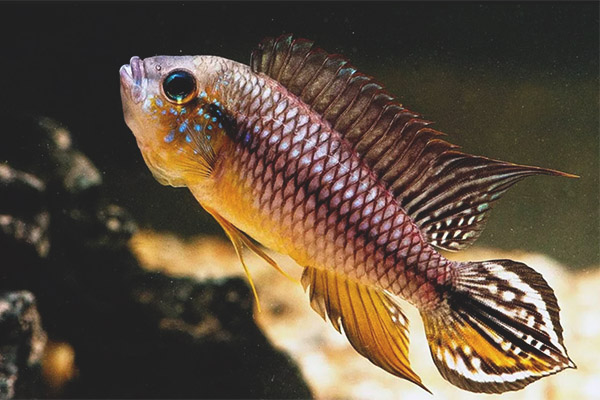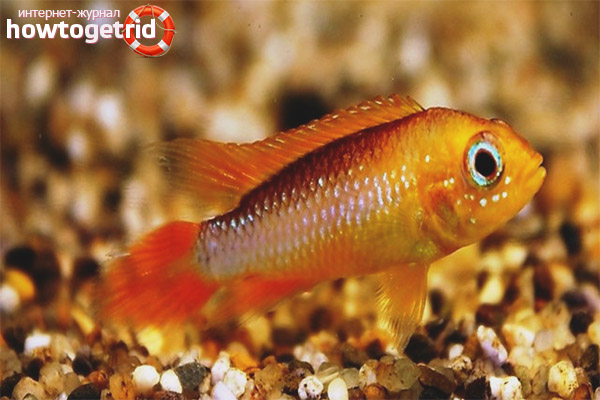The content of the article
Apastograms of agassica or flare are beautiful, bright and compact in size fish. Depending on the places where they live, their colors can differ from each other, and breeders face the challenge of constantly developing new types and types of colors.
In addition to bright colors and small sizes - no more than 8 centimeters, they are distinguished by their peace-loving disposition. In comparison with the rest of the cichlids, they are just babies, it is very convenient for keeping them in a small aquarium. However, they are quite capricious in their care and they are preferred by owners who do not have the opportunity to start large aquariums. The main problem is that the water is really clean.They are sensitive to ammonia and nitrates, to a sufficient level in water O2. When the oxygen content in the water is low, the agassics can get sick and even die.
They may be called fish, which may well be kept in the general aquarium together with other relatives. They are not aggressive and small in size, but with very small fish they are still not worth settling together.
How do they live in natural conditions?
The first mention of agassiss apistograms was recorded in the 75th year of the 19th century. They come from South America, where they live in the Amazon River. It is to the habitat that they owe their spectacular color, which depends on their place of origin.
Their favorite places are where there is no strong flow. Where they live, at the bottom is fallen leaves from tropical plants, and the water has a rather dark color due to the fact that these leaves emit tannins.
Fact! The males of the agassian apistorgamma are prone to polygamous relationships. They, as a rule, choose for themselves several females for family relations.
Appearance
Peculiarities of care
Representatives of this breed preferably contain those who have experience in breeding cyclides of another species. They are small, non-aggressive, not capricious with regards to food. But they are quite picky in terms of living conditions.
Nutrition
Absolutely omnivorous fish that feed on small insects and various benthic benthic. In an aquarium setting, they preferably eat live or frozen food: moths, tubule, coretru, artemia, and feed produced in an industrial environment.
Due to the fact that these fish are extremely demanding on the quality of water, feeding should be done several times a day, giving food in small quantities so that its remains do not remain in the water.
Conditions of detention
Aquariums with a volume of up to 80 liters are most suitable for living agassica apistograms.For them, it is important to constantly maintain the conditions and purity of water. It should have a pH of 5 to 7 and a temperature of about 25 degrees. Gradually, they get used to the conditions in which they are located, even if they are not quite comfortable. But these fish breed only in favorable conditions.
It is extremely important to control the level of nitrates and ammonia in the water. These substances greatly affect the apistogram of the Agassic. Siphon the bottom regularly and maintain clean water. The complexity of the content lies in the fact that agassics are extremely susceptible to the composition of water, the presence of extraneous chemical compounds in it.
Regarding the scenery, the best option is wood, pots and coconut halves. Fish need shelters, because in natural conditions they are actively using them. It is desirable that the aquarium was more vegetation. The bottom should be laid out with small stones, such as gravel or basalt. This is a comfortable ground for agassics. Moreover, against the backdrop of such decor, they look very expressive and impressive.
Neighborhood with other inhabitants of the aquarium
Many owners of domestic fish worry about whether it is possible to keep the agassits apistograms in the same environment as others.The basic rule of successful cohabitation is that they are approximately the same size. If the content of the male is planned, then the aquarium should be more spacious.
Their neighbors may be small cichlids - Ramirezi's apistograms, cichlids - parrots or fish that love to live in the middle and upper layers - fiery barbs, rhodostomy, danio rerio.
Gender Differences
Male agassiss apistograms have large sizes relative to females and a brighter color. They have large and pointed fins. Females, in addition to smaller sizes, have less bright color and rounded tummy.
Breeding characteristics
For spawning, it is necessary to respect the level of pH 6 and the temperature in the region of 26 degrees. Females lay 40 to 150 eggs at a time. For the deposition of eggs, they need shelter, which can be inverted pots, halves of coconuts or snags. Eggs cling to the walls of the shelter, and the female takes care of them.After three - four days the larvae hatch from them, and after a few more days the fry begin to eat and swim.
After they begin to swim independently, the females continue to patronize them intently. They teach their children important skills for a future life. Feed the fry need liquid feed and ciliates. When they grow up a little, they are started to be fed with micro-worms and naubilia Artemia.
Video: aquarium fish apistogramma agassitsa












To send